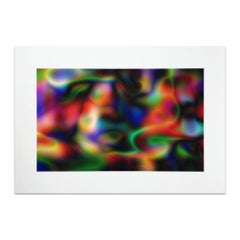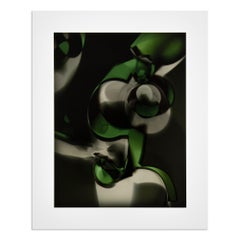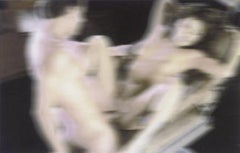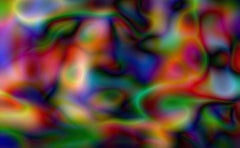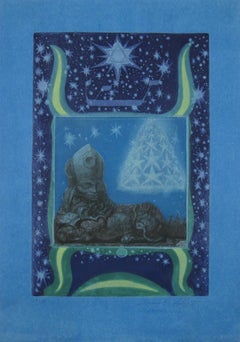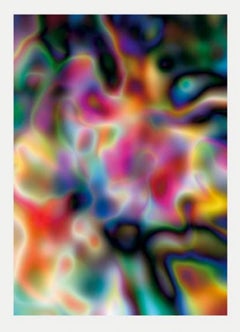Thomas Ruff Abstract Prints
German, b. 1958
Thomas Ruff is one of the most renowned living photographers. He currently lives in Düsseldorf's where he shares a studio with other important German photographers such as Laurenz Berges, Andreas Gursky and Axel Hütte.
Ruff was born in 1958 in Zell am Harmersbach, Germany and from 1977 to 1985, he attended Staatliche Kunstakademie, Düsseldorf. There he was taught by Bernd and Hilla Becher, who taught him about the conceptual aesthetics, how to break the standards and to use different techniques to reinforce the theme of his works.
Ruff has always been a fan of the large format, concerned about the finest details and the main concept of his work. He works in series which can be as varied as portraits, night visions, astral constellations, porn nudes, re-photographed internet commercials o industrial elements.
His Portrait series set him under the spotlight of the international photography scene. These where small and in black and white at the beginning but ended up being large scale of Passport like colour portraits of women and men on plain neutral backgrounds showing no sign of emotion thanks to a powerful flash.
Thomas Ruff is the opposite to traditional photography and believes in the use of multiple techniques to achieve perfection. He can use digital processes or take advantage of the latest computer-modelling software but can also play with photogram, the camera less technique advanced by Man Ray and László Moholy-Nagy in which the picture is created placing the objects directly on to a light sensitive materials, such as photographic paper.
His works are held in the collections of the Art Institute of Chicago, the Tate Gallery in London, the Kunstmuseum Basel, and The Museum of Modern Art in New York among many others.(Biography provided by Artetrama)
to
3
2
4
1
3
2
Overall Height
to
Overall Width
to
3
1
1
1
1
1
1
5
21
545
437
207
173
3
1
Artist: Thomas Ruff
Thomas Ruff, Substrat - Contemporary Photography, Abstract Art, Signed Print
By Thomas Ruff
Located in Hamburg, DE
Thomas Ruff (German, b. 1958)
Substrat, 2019
Medium: Chromogenic print
Dimensions: 32 × 45.8 cm (12 3/5 × 18 in)
Edition of 300: Hand-signed and numbered in pencil
Condition: Excellent
Category
21st Century and Contemporary Abstract Thomas Ruff Abstract Prints
Materials
C Print
Thomas Ruff, PHG.S.01 - Chromogenic Print, Abstract Photography, Signed Print
By Thomas Ruff
Located in Hamburg, DE
Thomas Ruff (German, b. 1958)
PHG.S.01, 2020
Medium: Chromogenic print
Dimensions: 11 4/5 × 9 2/5 in (30 × 24 cm)
Edition of 100: Hand signed and numbered, verso
Condition: Mint
Category
21st Century and Contemporary Abstract Thomas Ruff Abstract Prints
Materials
C Print
Nudes em 08
By Thomas Ruff
Located in New York, NY
A very good impression of this Iris print. Signed and numbered 23/50 on verso by Ruff.
Category
Early 2000s Contemporary Thomas Ruff Abstract Prints
Materials
Color
Thomas Ruff
By Thomas Ruff
Located in 'S-GRAVENHAGE, ZH
Medium: Chromogenic print
Size: 32 x 45.8 cm (12 3/5 x 18 in)
Edition of 300
Signed and numbered verso
Category
2010s Thomas Ruff Abstract Prints
Materials
C Print
Substrat 21 III 2003/19
By Thomas Ruff
Located in New York, NY
2019
Chromogenic print
Sheet: 12 3/5 x 18 in. (32 x 45.7 cm)
Edition of 300
Signed, dated and numbered in pencil on verso
Unframed, excellent condition
Category
2010s Abstract Thomas Ruff Abstract Prints
Materials
Digital
Related Items
Ernst Fuchs Sphinx Mystagoga Surreal Color Etching Vienna Fantastic Realism 1967
By Ernst Fuchs
Located in Meinisberg, CH
Ernst Fuchs
(Austrian, 1930 - 2015)
The Sphinx Mystagogo
Sheet Nr. 6 from the Folio “Die Sieben Bilder und Sprüche der Sphinx”, published in Autumn of 1967 by Galerie Sydow in Frankfurt, Germany.
• Aquatint Etching
• Ed. 79/99
• Sheet ca. 59 x 41.5 cm
• Plate signed
• Signed & numbered by the artist in pencil
Worldwide shipping for this object is complimentary - There are no additional charges for handling & delivery.
Ernst Fuchs was an Austrian painter, draftsman, printmaker, sculptor, architect, stage designer, composer, poet, and one of the founders of the Vienna School of Fantastic Realism.
I discovered him through H.R. Giger ‘s work, who himself was greatly inspired by the creations of Fuchs and on several occasions exhibited his friend ‘s art in his museum, the Château St-Germain, Gruyères, Switzerland.
I actually own the original folio box...
Category
1960s Surrealist Thomas Ruff Abstract Prints
Materials
Paper, Ink, Aquatint, Etching
Free Shipping
H 23.23 in W 16.34 in
Nude with Veils ( Nu aux Voilettes) Salvador Dali Original Engraving 1975
By Salvador Dalí
Located in Paonia, CO
Nude with Veils ( Nu aux Voilettes ) portrays a female nude with long hanging breasts, a crutch instead of a head and a veil streaming off the top of the crutch with the left ar...
Category
1970s Surrealist Thomas Ruff Abstract Prints
Materials
Engraving
Blue Flowing Curved Shapes, Modern Mid-Century Print on Paper, Blues, Neutral
By Kind of Cyan
Located in Barcelona, ES
This is an exclusive handprinted unique cyanotype that takes its inspiration from mid-century modern style shapes.
It's made by layering paper cutouts and different exposures using ...
Category
2010s Modern Thomas Ruff Abstract Prints
Materials
Photographic Film, Emulsion, Printer's Ink, Watercolor, Photographic Pap...
German Surrealist Hans Bellmer Etching Engraving Print Cecile Reims Surrealism
By Hans Bellmer
Located in Surfside, FL
After Hans Bellmer (German, 1902-1975)
Surrealist engraving, etching
after drawings from a 1942 notebook,
engraved in 1974-75 by Cecile Reims
Printed by L'Atelier de Chalcographie du Louvre, Paris,
Having printed monogram lower left in plate, pencil notations and #7/10 and 'Musee du Louvre' blindstamp verso
Dimensions: Sheet 11 X 7.5, Plate size 6.5 X 4
Hans Bellmer ( 1902 – 1975) was a Polish born German artist, best known for his drawings, etchings that illustrates the 1940 edition of Histoire de l’œil, and the life-sized female sculpture mannequin dolls he produced in the mid-1930s. Historians of art and photography also consider him a Surrealist photographer.
Bellmer was born in the city of Kattowitz, then part of the German Empire (now Katowice, Poland). Up until 1926, he worked as a draftsman for his own advertising company.
Bellmer is most famous for the creation of a series of dolls as well as photographs of them. He was influenced in his choice of art form in part by reading the published letters of Oskar Kokoschka (Der Fetisch, 1925) and Surrealism. Bellmer's puppet doll project is also said to have been catalysed by a series of events in his personal life.
Hans Bellmer takes credit for provoking a physical crisis in his father and brings his own artistic creativity into association with childhood insubordination and resentment toward a severe and humorless paternal authority. Perhaps this is one reason for the nearly universal, unquestioning acceptance in the literature of Bellmer's promotion of his art as a struggle against his father, the police, and ultimately, fascism and the state. Events of his personal life also including meeting a beautiful teenage cousin in 1932 (and perhaps other unattainable beauties), attending a performance of Jacques Offenbach's Tales of Hoffmann (in which a man falls tragically in love with an automaton), and receiving a box of his old toys. After these events, he began to actually construct his first dolls. In his works, Bellmer explicitly sexualized the doll as a young girl (his work bears connection to the works of Bathus). Hirschfeld has claimed (without further argumentation) that Bellmer initiated his doll project to oppose the fascism of the Nazi Party by declaring that he would make no work that would support the new German state. Represented by mutated forms and unconventional poses, his dolls (according to this view) were directed specifically at the cult of the perfect body then prominent in Germany.
He visited Paris in 1935 and made contacts there, such as Paul Éluard, but returned to Berlin because his wife Margarete was dying of tuberculosis. He was part of the circle of Surrealist luminaries such as Man Ray, Marcel Duchamp, Max Ernst, Joan Miro, André Masson, René Magritte, Alberto Giacometti and Salvador Dali as well as women artists—such as Frida Kahlo, Dorothea Tanning and Leonora Carrington.
Bellmer produced the first doll in Berlin in 1933. Long since lost, the assemblage can nevertheless be correctly described thanks to approximately two dozen photographs Bellmer took at the time of its construction. Standing about fifty-six inches tall, the doll consisted of a modeled torso made of flax fiber, glue, and plaster; a mask-like head of the same material with glass eyes and a long, unkempt wig; and a pair of legs made from broomsticks or dowel rods. One of these legs terminated in a wooden, club-like foot; the other was encased in a more naturalistic plaster shell, jointed at the knee and ankle. As the project progressed, Bellmer made a second set of hollow plaster legs, with wooden ball joints for the doll's hips and knees. There were no arms to the first sculpture, but Bellmer did fashion or find a single wooden hand, which appears among the assortment of doll parts the artist documented in an untitled photograph of 1934, as well as in several photographs of later work.
Bellmer's 1934 anonymous book, The Doll (Die Puppe), produced and published privately in Germany, contains 10 black-and-white photographs of Bellmer's first doll arranged in a series of "tableaux vivants" (living pictures). The book was not credited to him, as he worked in isolation, and his photographs remained almost unknown in Germany. Yet Bellmer's work was eventually declared "degenerate" (entartete kunst) by the Nazi Party, and he was forced to flee Germany to France in 1938, where Bellmer's work was welcomed by the Surrealists around Andre Breton.
He aided the French Resistance during the war by making fake passports. He was imprisoned in the Camp des Milles prison at Aix-en-Provence, a brickworks camp for German nationals, from September 1939 until the end of the Phoney War in May 1940.
After the war, Bellmer lived the rest of his life in Paris. Bellmer gave up doll-making and spent the following decades creating erotic drawings, etchings, sexually explicit photographs, paintings, and prints of pubescent girls. In 1954, he met Unica Zürn...
Category
20th Century Thomas Ruff Abstract Prints
Materials
Etching
Geometric Triangles Pattern, Cutout Layer Paper Cyanotype in Blue, Naif Shapes
By Kind of Cyan
Located in Barcelona, ES
This is an exclusive handprinted unique cyanotype that takes its inspiration from the mid-century modern shapes.
It's made by layering paper cutouts and different exposures using uv-...
Category
2010s Abstract Geometric Thomas Ruff Abstract Prints
Materials
Photographic Film, Photogram, Monotype, Color, C Print, Photographic Pap...
Handmade Cutouts Monotype, Blue and White Moonlight Reflection Contours, Unique
By Kind of Cyan
Located in Barcelona, ES
This is an exclusive handprinted unique cyanotype that takes its inspiration from mid-century modern shapes.
It's made by layering paper cutouts and different exposures using uv-ligh...
Category
2010s Abstract Geometric Thomas Ruff Abstract Prints
Materials
Photographic Film, Photogram, Monotype, Color, C Print, Photographic Pap...
Futurist Transparent Shapes, Primary Geometry, White & Blue, Triangles, Circles
By Kind of Cyan
Located in Barcelona, ES
This is an exclusive handprinted unique cyanotype that takes its inspiration from the mid-century modern shapes.
It's made by layering paper cutouts and different exposures using uv-...
Category
2010s Abstract Geometric Thomas Ruff Abstract Prints
Materials
Photographic Film, Emulsion, Printer's Ink, Watercolor, Photographic Pap...
Free Shipping
H 20 in W 28 in
Wolfgang Tillmans, Texte zur Kunst Edition 2018: Photography, Signed Print
By Wolfgang Tillmans
Located in Hamburg, DE
Wolfgang Tillmans (German, born 1968)
Texte zur Kunst Edition 2018, 2018
Medium: Inkjet print on paper
Dimensions: 29.5 × 21 cm (11 3/5 × 8 3/10 in)
Edition of 100: Hand-signed and n...
Category
21st Century and Contemporary Abstract Thomas Ruff Abstract Prints
Materials
Inkjet
I Could Feel You
By Tracey Emin
Located in New York, NY
Tracey Emin
I Could Feel You, 2015
Archival quality giclée print on Purcell Ultrasmooth Fine Art Paper 300 GSM
9 1/2 × 12 inches
Plate signed
Unframed
Rare archival quality, giclée reproduction of Tracey Emin's original gouache I Could Feel You, which is in the permanent modern art collection of the Tate. This was printed back in 2015 in an undisclosed limited edition, and is now long sold out.
More details about the original 2014 work are on the Tate Gallery's website as follows:
Emin, whose work is often candidly autobiographical, scrutinises her relationship with her own body, using drawing...
Category
2010s Contemporary Thomas Ruff Abstract Prints
Materials
Giclée
German Surrealist Hans Bellmer Etching Engraving Print Cecile Reims Surrealism
By Hans Bellmer
Located in Surfside, FL
After Hans Bellmer (German, 1902-1975)
Surrealist engraving, etching
after drawings from a 1942 notebook,
engraved in 1974-75 by Cecile Reims
Printed by L'Atelier de Chalcographie du Louvre, Paris,
Having printed monogram lower left in plate, pencil notations verso Editioned from a very small edition of #7/10
'Musee du Louvre' blindstamp.
Dimensions: Sheet 11 X 7.5, Plate size 6.5 X 4
Hans Bellmer ( 1902 – 1975) was a Polish born German artist, best known for his drawings, etchings that illustrates the 1940 edition of Histoire de l’œil, and the life-sized female sculpture mannequin dolls he produced in the mid-1930s. Historians of art and photography also consider him a Surrealist photographer.
Bellmer was born in the city of Kattowitz, then part of the German Empire (now Katowice, Poland). Up until 1926, he worked as a draftsman for his own advertising company.
Bellmer is most famous for the creation of a series of dolls as well as photographs of them. He was influenced in his choice of art form in part by reading the published letters of Oskar Kokoschka (Der Fetisch, 1925) and Surrealism. Bellmer's puppet doll project is also said to have been catalysed by a series of events in his personal life.
Hans Bellmer takes credit for provoking a physical crisis in his father and brings his own artistic creativity into association with childhood insubordination and resentment toward a severe and humorless paternal authority. Perhaps this is one reason for the nearly universal, unquestioning acceptance in the literature of Bellmer's promotion of his art as a struggle against his father, the police, and ultimately, fascism and the state. Events of his personal life also including meeting a beautiful teenage cousin in 1932 (and perhaps other unattainable beauties), attending a performance of Jacques Offenbach's Tales of Hoffmann (in which a man falls tragically in love with an automaton), and receiving a box of his old toys. After these events, he began to actually construct his first dolls. In his works, Bellmer explicitly sexualized the doll as a young girl (his work bears connection to the works of Bathus). Hirschfeld has claimed (without further argumentation) that Bellmer initiated his doll project to oppose the fascism of the Nazi Party by declaring that he would make no work that would support the new German state. Represented by mutated forms and unconventional poses, his dolls (according to this view) were directed specifically at the cult of the perfect body then prominent in Germany.
He visited Paris in 1935 and made contacts there, such as Paul Éluard, but returned to Berlin because his wife Margarete was dying of tuberculosis. He was part of the circle of Surrealist luminaries such as Man Ray, Marcel Duchamp, Max Ernst, Joan Miro, André Masson, René Magritte, Alberto Giacometti and Salvador Dali as well as women artists—such as Frida Kahlo, Dorothea Tanning and Leonora Carrington.
Bellmer produced the first doll in Berlin in 1933. Long since lost, the assemblage can nevertheless be correctly described thanks to approximately two dozen photographs Bellmer took at the time of its construction. Standing about fifty-six inches tall, the doll consisted of a modeled torso made of flax fiber, glue, and plaster; a mask-like head of the same material with glass eyes and a long, unkempt wig; and a pair of legs made from broomsticks or dowel rods. One of these legs terminated in a wooden, club-like foot; the other was encased in a more naturalistic plaster shell, jointed at the knee and ankle. As the project progressed, Bellmer made a second set of hollow plaster legs, with wooden ball joints for the doll's hips and knees. There were no arms to the first sculpture, but Bellmer did fashion or find a single wooden hand, which appears among the assortment of doll parts the artist documented in an untitled photograph of 1934, as well as in several photographs of later work.
Bellmer's 1934 anonymous book, The Doll (Die Puppe), produced and published privately in Germany, contains 10 black-and-white photographs of Bellmer's first doll arranged in a series of "tableaux vivants" (living pictures). The book was not credited to him, as he worked in isolation, and his photographs remained almost unknown in Germany. Yet Bellmer's work was eventually declared "degenerate" (entartete kunst) by the Nazi Party, and he was forced to flee Germany to France in 1938, where Bellmer's work was welcomed by the Surrealists around Andre Breton.
He aided the French Resistance during the war by making fake passports. He was imprisoned in the Camp des Milles prison at Aix-en-Provence, a brickworks camp for German nationals, from September 1939 until the end of the Phoney War in May 1940.
After the war, Bellmer lived the rest of his life in Paris. Bellmer gave up doll-making and spent the following decades creating erotic drawings, etchings, sexually explicit photographs, paintings, and prints of pubescent girls. In 1954, he met Unica Zürn...
Category
20th Century Thomas Ruff Abstract Prints
Materials
Etching
Marble Reflections Diptych in Green Emerald Stone, Pale Swirls, Abstract Shapes
By Ryan Rivadeneyra
Located in Barcelona, ES
Cyd Fontaine (Lausanne, 1992) is a contemporary artist renowned for her captivating use of dreamy atmospheric gradients, which has helped her carve a distinctive niche in the world o...
Category
2010s Contemporary Thomas Ruff Abstract Prints
Materials
Photographic Film, Archival Ink, Photographic Paper, C Print, Digital, G...
Free Shipping
H 36 in W 48 in
STCBe-Contemporary, Abstract prints, stil-life, figurative, nude, landscape
By Francisco Nicolás
Located in London, London
"I printed my love on some pages of your book"
Digital pigment print Ultrachrome ink on Fabriano Rosaspina paper. Hand signed by the artist, and certificate of authenticity. (Unfra...
Category
2010s Abstract Thomas Ruff Abstract Prints
Materials
C Print, Digital, Inkjet, Giclée, Archival Pigment, Digital Pigment
H 39.38 in W 27.56 in D 0.4 in
Previously Available Items
Substrat, Contemporary Photography, Abstract Art
By Thomas Ruff
Located in Hamburg, DE
Thomas Ruff (German, b. 1958)
Substrat, 2019
Medium: Chromogenic print
Dimensions: 32 × 45.8 cm (12 3/5 × 18 in)
Edition of 300: Hand signed and numbered in pencil
Condition: Excellent
Category
21st Century and Contemporary Abstract Thomas Ruff Abstract Prints
Materials
C Print
Substrate A
By Thomas Ruff
Located in Long Island City, NY
Thomas Ruff uses technological advancements to realize new visual possibilities of photography and question its artistic qualities. This is an abstract print from his 2003 Substrate...
Category
Early 2000s Abstract Thomas Ruff Abstract Prints
Materials
C Print
Thomas Ruff abstract prints for sale on 1stDibs.
Find a wide variety of authentic Thomas Ruff abstract prints available for sale on 1stDibs. You can also browse by medium to find art by Thomas Ruff in c print, digital print, lithograph and more. Much of the original work by this artist or collective was created during the 21st century and contemporary and is mostly associated with the abstract style. Not every interior allows for large Thomas Ruff abstract prints, so small editions measuring 10 inches across are available. Customers who are interested in this artist might also find the work of Daniel Richter, Friedel Dzubas, and Günther Förg. Thomas Ruff abstract prints prices can differ depending upon medium, time period and other attributes. On 1stDibs, the price for these items starts at $2,164 and tops out at $6,103, while the average work can sell for $3,786.
